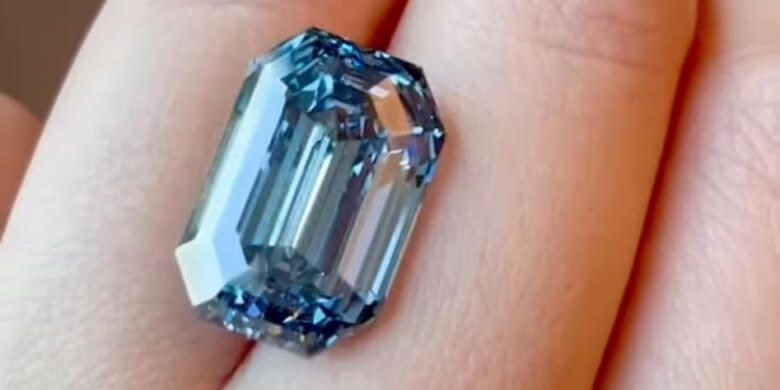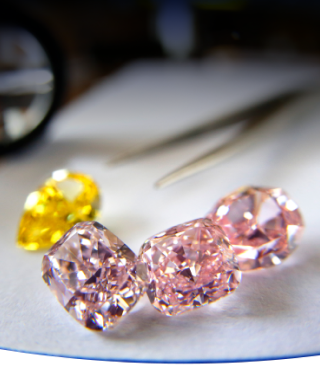Sotheby’s Hong Kong, The De Beers Cullinan Blue, April 27, 2022
As most of the industry has been prevented from traveling to Hong Kong during this challenging period, this auction analysis can help those who would like to bid without physically inspecting the goods.
For your convenience, we have added a direct link to the GIA report.
Lot: 1800
Description: 15.10 ct, Fancy Vivid Blue, Emerald, IF
Price Realized: $3,805,561pc
Rarity: A similar diamond enters the market once every…Check Rarity Here.
GIA Report: View
Image and Video taken by Sotheby’s

Analysis:
A large, Vivid Blue diamond sourced from the Cullinan mine in South Africa. According to media publications, the 39.34 carat rough diamond was purchased by De Beers in July 2021 for $40 million (~$2.65 million per carat for the polished diamond).
Although the GIA defines this shape as a Cut-Cornered Step Cut, it has all the visual attributes of a classic Emerald Cut, and as such, it should be referred to as one. Its Internally Flawless clarity grade adds grace to the gemological findings, though this clarity grade is not very rare among Blue Fancy color diamonds.
Generally speaking, Polish and Symmetry had never been an important factor in fancy color diamonds, as they don’t impact the way color is experienced in a stone. High grades of Polish and Symmetry are not highly prioritized in the manufacturing process in fancy color diamonds, especially when there are weight constraints. Having said that, we consider it a bit unusual to come across such a large and important fancy color diamond with a “Good” symmetry grade. We assume this was a conscious decision, as pursuing a higher symmetry grade would have led to a great deal of lost weight, and as a result, would have significantly increased the stone’s cost-per-carat. The extra facet in one of the corners is an indication to an unresolved issue which probably prevented a higher symmetry grade.
The color dispersion is low, as the large colorless area has taken over most of its face-up view; however, the industry norm is to be more forgiving when judging dispersion on an elongated Step Cut diamond (1:1.5 ratio in this case), when the colorless area is bright and not dark.
The Vivid Inner-Grade is above the average saturation seen in most Vivid Blue diamonds and should meet one’s expectations of a Vivid Blue. No grey undertone is seen in the hue, creating an absolute blue color sensation.
Visual Assets:
Inner Grade Hue |
Color Dispersion |
Undertone |
Quality Remark |
|
15.10 ct, F.V.B., EM, IF |
3 |
2 |
4 |
– |
Total Visual Score 9 out of 12
General
We use 1, 2, 3, 4, and 4+ to grade the three visual elements that GIA is silent about, although they impact the value dramatically.
Inner-Grade refers to the strength of color within each GIA saturation category:
Grade 1 weakest, bordering the saturation below.
Grade 2 weak (most common).
Grade 3 full-bodied color (above average).
Grade 4 very strong saturation.
Grade 4+ applies to the vivid category only, exhibiting the strongest possible saturation (rarely seen).
Undertone refers to a subtle hue influence in the body color of the stone.
For example:
A Fancy Blue Diamond with a significant gray presence in its general appearance will be graded with a low undertone grade of 1. A Fancy Blue that has no gray influence that is close to a primary blue will receive the grade, 4.
In a Pink Fancy Color Diamond, a stone with a warm undertone (such as orange or brown) will receive a low undertone grade. A pink stone with a cold undertone (such as purple) will receive a high grade.
In Yellow Fancy Color Diamonds, low foreign influence or a light orange influence will grant the stone a high undertone grade. When the yellow undertone looks like a true primary yellow, it will receive the rare grade 4+. Green and brown undertones will grant a low grade in the yellow category.
Color Dispersion relates to how well the color is dispersed in the face-up view of a Fancy Color Diamond, regardless as to whether the GIA grades the stone as even. A stone with many colorless areas will receive a grade of 1, while a stone that exhibits its face-up view with no colorless patches will receive a grade of 4+. Unlike the first two elements, the color dispersion is not a gemological quality and is the result of cutter proficiency.


